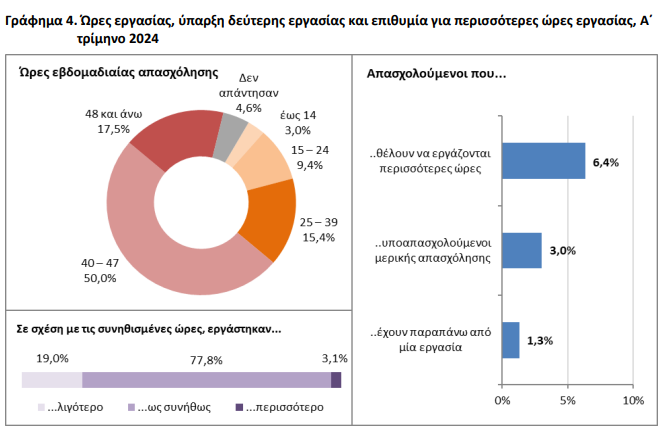Of the total unemployed, approximately 300,000 people or 52% of the total are long-term unemployed, i.e. they have been looking for work for a year or more without success
The unemployment rate in the country reached 12.1% in the first quarter of this year, from 10.5% in Q4 2023 and against 11.8% in the first quarter last year.
THE number of unemployed amounted to 574,130 people, presenting an increase of 17.5% compared to the previous quarter and by 4.3%, compared to the corresponding quarter of the previous year. Of the total unemployed, about 300,000 people or 52% of the total are long-term unemployed, meaning they have been looking for work for a year or more without success.
At women the unemployment rate stood at 15.2% and to men in 9.7%.
Age-wise, in the 15-19 year old age group the unemployment rate reached 47.6% and in the 20-24 year old age group to 23.4%. They are followed by the ages 25-29 years (20.2%), 30-44 years (12.2%), 45-64 years (8.9%) and 65 years and over (6.4%).
At the level of regions of the country, the first three places are the Ionian Islands (31.1%), the South Aegean (16.6%) and Crete (16%). They are followed by Central Macedonia (14.3%), Western Macedonia (14.3%), Thessaly (12.8%), Western Greece (11.7%), Eastern Macedonia-Thrace (10.7 %), Attica (10.3%), Epirus (10.2%), Central Greece (9.6%), Peloponnese (9.1%) and North Aegean (7.7%).
From the data of the ELSTAT labor force survey it also appears that the main reasons the unemployed stopped working are either because their work was of limited duration and ended (35.9%) or because they were fired (14.5%). The percentage of the unemployed who have not worked in the past (young unemployed) is 22.9%.
The percentage of the unemployed who have been looking for work for a year or more (long-term unemployed) amounts to 52%. The majority of the unemployed have completed up to secondary education (60.2%). The percentage of the unemployed who declare that they are not registered with DYPA (OAED) amounts to 21.4%, while the percentage of those who declare that they receive an allowance or assistance from DYPA (OAED) amounts to 15.6%.
The employed increased
The number of employed persons amounted to 4,173,424 persons, showing a decrease of 0.2% compared to the previous quarter and an increase of 1.8% compared to the corresponding quarter of the previous year.
The largest percentage of employed people work as employees (68.3%), while the percentage of self-employed people without staff is also significant (20.6%). The part-time employment rate stands at 7.9%, showing an increase of 3.9% compared to the previous quarter and a decrease of 4.9% compared to the corresponding quarter of the previous year. The percentage of people with temporary work amounts to 8.2%, recording a decrease of 23.5% compared to the previous quarter and 12.0% compared to the corresponding quarter of the previous year.
The professions that gather the largest percentage of employees are those employed in the provision of services and sales (22.2%) and professionals (22.1%). Compared to the previous quarter, the largest increase is observed in operators of industrial plants, machinery and equipment (4.5%), while a greater decrease is observed in unskilled workers, manual workers and small professionals (5.6%). In relation to the corresponding quarter of the previous year, the largest increase is observed in office workers (6.9%), while a decrease is mainly observed in unskilled workers, manual workers and small professionals (8.7%) and in technicians and practitioners of related professions (4 .6%).
What the figures say about working hours
50% of the employed state that they worked 40-47 hours in the reference week, while a significant percentage (17.5%) state that they worked 48 or more hours. The majority of employed people (77.8%) state that they worked normal hours during the reference week. 6.4% of those employed say they would like to work more hours, 3% are part-time underemployed who would like to work more, and could start working more within the next two weeks, and 1.3 % has more than one job.
92.2% of people outside the labor force say they do not want to work
People not in the labor force, or “people outside the labor force” (those not working or looking for work), totaled 4,278,162 people. In particular, people outside the labor force under the age of 75 amounted to 3,049,185 people. Their percentage decreased by 2.5% compared to the previous quarter and by 3.8% compared to the corresponding quarter of the previous year.
The majority of people outside the labor force aged 15-74 have either never worked before (45.7%) or it has been more than 8 years since they left their last job (30%). Of those who had worked within the last 8 years, the largest proportion stopped working because they retired (55.1%), or because their work was of limited duration and ended (20.7%).
Finally, 92.2% of people outside the labor force say they do not want to work. 1.6% say they are looking for work but are not immediately available to take it, while 3.3% say they are available to take work immediately but are not looking.
Source: Skai
I am Janice Wiggins, and I am an author at News Bulletin 247, and I mostly cover economy news. I have a lot of experience in this field, and I know how to get the information that people need. I am a very reliable source, and I always make sure that my readers can trust me.












